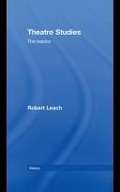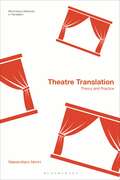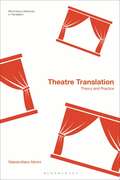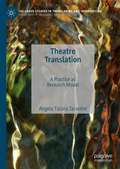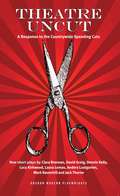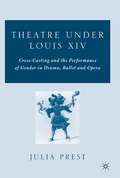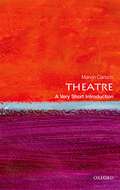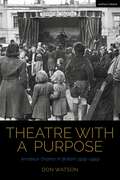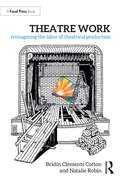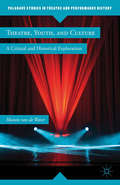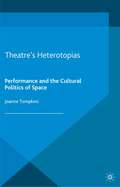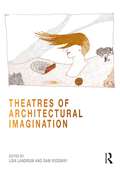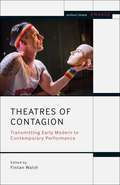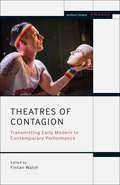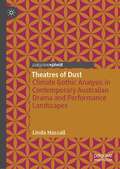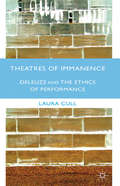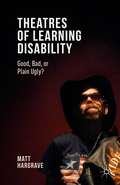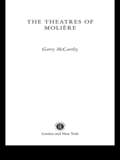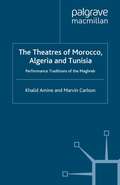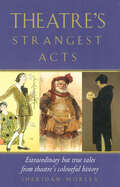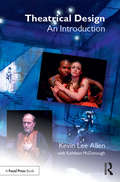- Table View
- List View
Theatre Studies (The Basics) (PDF)
by Robert LeachThis is an essential read for anyone setting out to study the thrilling world of theatre for the first time. Introducing you to all the aspects of drama, theatre and performance you will be studying in your course, from the theoretical to the practical. Theatre Studies: The Basics will take you through such topics as: dramatic genres, from tragedy to political documentary theories of performance, the history of the theatre in the West and acting, directing and scenography the audience. Theatre Studies: The Basics has all you need to get your studies off to a flying start.nbsp;
Theatre Translation: Theory and Practice (Bloomsbury Advances in Translation)
by Massimiliano MoriniTranslation for the theatre is often considered to hold a marginal status between literary translation and adaptation for the stage. As a result, this book argues that studies of this complex activity tend to take either a textual or performative approach. After exploring the history of translation theory through these lenses, Massimiliano Morini proposes a more totalizing view of 'theatre translation' as the sum of operations required to transform one theatre act into another, and analyses three complex Western case histories in light of this all-encompassing definition. Combining theory with practice, Morini investigates how traditional ideas on translation – from Plautus and Cicero to the early 20th century – have been applied in the theatrical domain. He then compares and contrasts the inherently textual viewpoint of post-humanistic translators with the more performative approaches of contemporary theatrical practitioners, and chronicles the rise of performative views in the third millennium. Positioning itself at the intersection of past and present, as well as translation studies and theatre semiotics, Theatre Translation provides a full diachronic survey of an age-old activity and a burgeoning academic field.
Theatre Translation: Theory and Practice (Bloomsbury Advances in Translation)
by Massimiliano MoriniTranslation for the theatre is often considered to hold a marginal status between literary translation and adaptation for the stage. As a result, this book argues that studies of this complex activity tend to take either a textual or performative approach. After exploring the history of translation theory through these lenses, Massimiliano Morini proposes a more totalizing view of 'theatre translation' as the sum of operations required to transform one theatre act into another, and analyses three complex Western case histories in light of this all-encompassing definition. Combining theory with practice, Morini investigates how traditional ideas on translation – from Plautus and Cicero to the early 20th century – have been applied in the theatrical domain. He then compares and contrasts the inherently textual viewpoint of post-humanistic translators with the more performative approaches of contemporary theatrical practitioners, and chronicles the rise of performative views in the third millennium. Positioning itself at the intersection of past and present, as well as translation studies and theatre semiotics, Theatre Translation provides a full diachronic survey of an age-old activity and a burgeoning academic field.
Theatre Translation: A Practice as Research Model (Palgrave Studies in Translating and Interpreting)
by Angela Tiziana TarantiniThis book examines the effects of translation on theatrical performance. The author adapts and applies Kershaw et al.’s Practice as Research model to an empirical investigation analysing the effects of translation on the rhythm and gesture of a playtext in performance, using the contemporary plays Convincing Ground and The Gully by Australian playwright David Mence which have been translated into Italian. The book is divided into two parts: a theoretical exegesis encompassing Translation Studies, Performance Studies and Gesture Studies, and a practical investigation comprising of a workshop where excerpts of the plays are explored by two groups of actors. The chapters are accompanied by short clips of the performance workshop hosted on SpringerLink. The book will be of interest to students and scholars in the fields of Translation Studies (and Theatre Translation more specifically), Theatre and Performance, and Gesture Studies.
Theatre Uncut: A Response to the Countrywide Spending Cuts (Oberon Modern Plays)
by Dennis Kelly Clara Brennan David GreigAcross the UK thousands of people are involved in protests and debates, sparked into action by the largest cuts to public spending since WWII – cuts which are the turning point of a generation, undermining the welfare state, higher education and the arts in one fell swoop. Theatre Uncut is a national theatre event in response to these cuts, bringing together some of the UK’s leading dramatists. Theatre Uncut’s flagship event took place in London from 16- 19 March 2011. Drama groups, universities, youth clubs and theatre companies nationwide joined the event, staging their own versions of the shorts in a national theatrical uprising. Now published in this new collection, Theatre Uncut containsthese short plays, addressing audiences who want to think about what the budget cuts really mean, and who they are really hitting. A debate is underway. Protest might begin, minds might be changed, views challenged, ideas formed. Theatre Uncut is a response to a situation that we cannot control, and over whichwe had no say.
Theatre Under Louis XIV: Cross-Casting and the Performance of Gender in Drama, Ballet and Opera
by J. PrestThis book explores the fascinating phenomenon of cross-casting and related gender issues in different theatrical genres and different performance contexts during the heyday of French theatre. Although professional acting troupes under Louis XIV were mixed, cross-casting remained an important feature of French court ballet (in which the King himself performed a number of women's roles) and an occasional feature of spoken comedy and tragic opera. Cross-casting also persisted out of necessity in the school drama of the period. This book fills an important gap in the history of French theatre and provides new insight into wider theoretical questions of gender and theatricality. The inclusion of chapters on ballet and opera (as well as spoken drama) opens up the richness of French theatre under Louis XIV in a way that has not been achieved before.
Theatre: A Very Short Introduction (Very Short Introductions)
by Marvin CarlsonFrom before history was recorded to the present day, theatre has been a major artistic form around the world. From puppetry to mimes and street theatre, this complex art has utilized all other art forms such as dance, literature, music, painting, sculpture, and architecture. Every aspect of human activity and human culture can be, and has been, incorporated into the creation of theatre. In this Very Short Introduction Marvin Carlson takes us through Ancient Greece and Rome, to Medieval Japan and Europe, to America and beyond, and looks at how the various forms of theatre have been interpreted and enjoyed. Exploring the role that theatre artists play — from the actor and director to the designer and puppet-master, as well as the audience — this is an engaging exploration of what theatre has meant, and still means, to people of all ages at all times. ABOUT THE SERIES: The Very Short Introductions series from Oxford University Press contains hundreds of titles in almost every subject area. These pocket-sized books are the perfect way to get ahead in a new subject quickly. Our expert authors combine facts, analysis, perspective, new ideas, and enthusiasm to make interesting and challenging topics highly readable.
Theatre with a Purpose: Amateur Drama in Britain 1919-1949 (Cultural Histories of Theatre and Performance)
by Don WatsonThis study of British amateur theatre in the inter-war period examines five different but interwoven examples of the belief, common in theatrical and educational circles at the time, that amateur drama had a purpose beyond recreation. Amateur theatre was at the height of its popularity as a cultural practice between the wars, so that by 1939 more British people had practical experience of putting on plays than at any time before or since.Providing an original account of the use of drama in adult education projects in deprived areas, and of amateur theatre in government-funded centres for the unemployed in the 1930s, it discusses repertoires, participation by working- class people and pioneering techniques of play-making. Amateur drama festivals and competitions were intended to raise standards and educate audiences. This book assesses their effect on play-making, and the use of innovative one-act plays to express contentious material, as well as looking at the Left Book Club Theatre Guild as an attempt to align the amateur theatre movement with anti-fascist and anti-war movements. A chapter on the Second World War rectifies the neglect of amateur theatre in war-time cultural studies, arguing that it was present and important in every aspect of war-time life.Don Watson builds on current scholarship and makes use of archival sources, local newspapers, unpublished scripts and the records of organizations not usually associated with the theatre. His work explores the range and diversity of amateur drama between the wars and the contributions it made to British theatre.
Theatre with a Purpose: Amateur Drama in Britain 1919-1949 (Cultural Histories of Theatre and Performance)
by Don WatsonThis study of British amateur theatre in the inter-war period examines five different but interwoven examples of the belief, common in theatrical and educational circles at the time, that amateur drama had a purpose beyond recreation. Amateur theatre was at the height of its popularity as a cultural practice between the wars, so that by 1939 more British people had practical experience of putting on plays than at any time before or since.Providing an original account of the use of drama in adult education projects in deprived areas, and of amateur theatre in government-funded centres for the unemployed in the 1930s, it discusses repertoires, participation by working- class people and pioneering techniques of play-making. Amateur drama festivals and competitions were intended to raise standards and educate audiences. This book assesses their effect on play-making, and the use of innovative one-act plays to express contentious material, as well as looking at the Left Book Club Theatre Guild as an attempt to align the amateur theatre movement with anti-fascist and anti-war movements. A chapter on the Second World War rectifies the neglect of amateur theatre in war-time cultural studies, arguing that it was present and important in every aspect of war-time life.Don Watson builds on current scholarship and makes use of archival sources, local newspapers, unpublished scripts and the records of organizations not usually associated with the theatre. His work explores the range and diversity of amateur drama between the wars and the contributions it made to British theatre.
Theatre Work: Reimagining the Labor of Theatrical Production
by Brídín Clements Cotton Natalie RobinTheatre Work: Reimagining the Labor of Theatrical Production investigates both the history and current realities of life and work in professional theatrical production in the United States and explores labor practices that are equitable, accessible, and sustainable.In this book, Brídín Clements Cotton and Natalie Robin investigate the question of artmaking, specifically theatrical production, as work. When the art is the work, how do employers navigate the balance between creative freedom and these equitable, accessible, and sustainable personnel processes? Do theatrical production operations value the worker? Through data analyses, worker narratives, and analogues to the evolving gig economy, Theatre Work questions everything about theatrical production work – including our shared history, ways of operating, and assumptions about how theatre is made – and considers what might happen if the American Theatre was reborn in an entirely new form.Written for members of the theatrical production workplace, leaders of theatrical institutions and productions, labor organizers, and industry union leaders, Theatre Work: Reimagining the Labor of Theatrical Production speaks to the ways that employers and workers can reimagine how we work.
Theatre Work: Reimagining the Labor of Theatrical Production
by Brídín Clements Cotton Natalie RobinTheatre Work: Reimagining the Labor of Theatrical Production investigates both the history and current realities of life and work in professional theatrical production in the United States and explores labor practices that are equitable, accessible, and sustainable.In this book, Brídín Clements Cotton and Natalie Robin investigate the question of artmaking, specifically theatrical production, as work. When the art is the work, how do employers navigate the balance between creative freedom and these equitable, accessible, and sustainable personnel processes? Do theatrical production operations value the worker? Through data analyses, worker narratives, and analogues to the evolving gig economy, Theatre Work questions everything about theatrical production work – including our shared history, ways of operating, and assumptions about how theatre is made – and considers what might happen if the American Theatre was reborn in an entirely new form.Written for members of the theatrical production workplace, leaders of theatrical institutions and productions, labor organizers, and industry union leaders, Theatre Work: Reimagining the Labor of Theatrical Production speaks to the ways that employers and workers can reimagine how we work.
Theatre, Youth, and Culture: A Critical and Historical Exploration (Palgrave Studies in Theatre and Performance History)
by Manon van de WaterThere is a complex relationship between performance, youth, and the shifting material circumstances (social, cultural, economic, ideological, and political) under which theatre for children and youth is generated and perceived. This book explores different aspect of theatre for young audiences using examples from theatrical events globally.
Theatre's Heterotopias: Performance and the Cultural Politics of Space (Contemporary Performance InterActions)
by J. TompkinsTheatre's Heterotopias analyses performance space, using the concept of heterotopia: a location that, when apparent in performance, refers to the actual world, thus activating performance in its culture. Case studies cover site-specific and multimedia performance, and selected productions from the National Theatre of Scotland and the Globe Theatre.
Theatres of Architectural Imagination
by Lisa LandrumThis volume explores connections between architecture and theatre, and encourages imagination in the design of buildings and social spaces. Imagination is arguably the architect’s most crucial capacity, underpinning memory, invention, and compassion. No simple power of the mind, architectural imagination is deeply embodied, social, and situational. Its performative potential and holistic scope may be best understood through the model of theatre. Theatres of Architectural Imagination examines the fertile relationship between theatre and architecture with essays, interviews and entr’actes arranged in three sections: Bodies, Settings, and (Inter)Actions. Contributions explore a global spectrum of examples and contexts, from ancient Rome and Renaissance Italy to modern Europe, North America, India, Iran, and Japan. Topics include the central role of the human body in design; the city as a place of political drama, protest, and phenomenal play; and world-making through language, gesture, and myth. Chapters also consider sacred and magical functions of theatre in Balinese and Persian settings; eccentric experiments at the Bauhaus and 1970 Osaka World Expo; and ecological action and collective healing amid contemporary climate chaos. Inspired by architect and educator Marco Frascari, the book performs as a Janus-like memory theatre, recalling and projecting the architect’s perennial task of reimagining a more meaningful world. This collection will delight and provoke thinkers and makers in theatrical arts and built environment disciplines, especially architecture, landscape, and urban design.
Theatres of Architectural Imagination
by Lisa Landrum Sam RidgwayThis volume explores connections between architecture and theatre, and encourages imagination in the design of buildings and social spaces. Imagination is arguably the architect’s most crucial capacity, underpinning memory, invention, and compassion. No simple power of the mind, architectural imagination is deeply embodied, social, and situational. Its performative potential and holistic scope may be best understood through the model of theatre. Theatres of Architectural Imagination examines the fertile relationship between theatre and architecture with essays, interviews and entr’actes arranged in three sections: Bodies, Settings, and (Inter)Actions. Contributions explore a global spectrum of examples and contexts, from ancient Rome and Renaissance Italy to modern Europe, North America, India, Iran, and Japan. Topics include the central role of the human body in design; the city as a place of political drama, protest, and phenomenal play; and world-making through language, gesture, and myth. Chapters also consider sacred and magical functions of theatre in Balinese and Persian settings; eccentric experiments at the Bauhaus and 1970 Osaka World Expo; and ecological action and collective healing amid contemporary climate chaos. Inspired by architect and educator Marco Frascari, the book performs as a Janus-like memory theatre, recalling and projecting the architect’s perennial task of reimagining a more meaningful world. This collection will delight and provoke thinkers and makers in theatrical arts and built environment disciplines, especially architecture, landscape, and urban design.
Theatres of Contagion: Transmitting Early Modern to Contemporary Performance (Methuen Drama Engage)
by Enoch Brater Mark Taylor-BattyTo what extent is theatre a contagious practice, capable of undoing and enlivening people and cultures? Theatres of Contagion responds to some of the anxieties of our current political and cultural climate by exploring theatre's status as a contagious cultural force, questioning its role in the spread or control of medical, psychological and emotional conditions and phenomena. Observing a diverse range of practices from the early modern to contemporary period, the volume considers how this contagion is understood to happen and operate, its real and imagined effects, and how these have been a source of pleasure and fear for theatre makers, audiences and authorities. Drawing on perspectives from medicine, neuroscience, psychology, anthropology, philosophy, law and affect theory, essays investigate some of the ways in which theatre can be viewed as a powerful agent of containment and transmission. Among the works analysed include a musical adaptation and an intercultural variation of Shakespeare's Romeo and Juliet; a contemporary queer take on Hamlet; Grand Guignol and theatres of horror; the writings and influence of Artaud; immersive theatre and the work of Punchdrunk, and computer gaming and smartphone apps
Theatres of Contagion: Transmitting Early Modern to Contemporary Performance (Methuen Drama Engage)
by Enoch Brater Mark Taylor-BattyTo what extent is theatre a contagious practice, capable of undoing and enlivening people and cultures? Theatres of Contagion responds to some of the anxieties of our current political and cultural climate by exploring theatre's status as a contagious cultural force, questioning its role in the spread or control of medical, psychological and emotional conditions and phenomena. Observing a diverse range of practices from the early modern to contemporary period, the volume considers how this contagion is understood to happen and operate, its real and imagined effects, and how these have been a source of pleasure and fear for theatre makers, audiences and authorities. Drawing on perspectives from medicine, neuroscience, psychology, anthropology, philosophy, law and affect theory, essays investigate some of the ways in which theatre can be viewed as a powerful agent of containment and transmission. Among the works analysed include a musical adaptation and an intercultural variation of Shakespeare's Romeo and Juliet; a contemporary queer take on Hamlet; Grand Guignol and theatres of horror; the writings and influence of Artaud; immersive theatre and the work of Punchdrunk, and computer gaming and smartphone apps
Theatres of Dust: Climate Gothic Analysis in Contemporary Australian Drama and Performance Landscapes
by Linda HassallThrough a contemporary Gothic lens, the book explores theatre theories, processes and practices that explore; the impacts of continuing drought and natural disaster, the conflicts concerning resource extraction and mining and current political debates focussed on climate change denial. While these issues can be argued from various political and economic platforms, theatrical investigations as discussed here suggest that scholars and theatre makers are becoming empowered to dramaturgically explore the ecological challenges we face now and may face in the future. In doing so the book proposes that theatre can engage in not only climate change analysis and discussion but can develop climate literacies in a broader socio-cultural context.
Theatres of Immanence: Deleuze and the Ethics of Performance
by Laura Cull Ó MaoilearcaTheatres of Immanence: Deleuze and the Ethics of Performance is the first monograph to provide an in-depth study of the implications of Deleuze's philosophy for theatre and performance. Drawing from Goat Island, Butoh, Artaud and Kaprow, as well from Deleuze, Bergson and Laruelle, the book conceives performance as a way of thinking immanence.
Theatres of Learning Disability: Good, Bad, or Plain Ugly?
by Matt HargraveWinner of the TaPRA New Career Research in Theatre/Performance Prize 2016 This is the first scholarly book to focus exclusively on theatre and learning disability as theatre, rather than advocacy or therapy. Hargrave provocatively realigns the - hitherto unvoiced - assumptions that underpin such practice and proposes that learning disabled artists have earned the right to full critical review.
The Theatres of Moliere (Theatre Production Studies)
by Gerry McCarthy Gerry MccarthyMoliere's plays are the cornerstone of the French Classical dramatic repertoire. Adapted and exploited in his day by dramatists of the English Restoration, they are now again growing in popularity. In this detailed and fascinating volume, Gerry McCarthy examines the practice and method of possibly the greatest actor-dramatist. From the rough farces of Moliere's days on the road to the creation of the diverse and spectacular court entertainments on his return to Paris, McCarthy sheds new light on the dramatic intelligence and theatrical understanding of Moliere's writing for the actor. Drawing on Moliere's own brief discussions of performance and the contemporary evidence of his practice, this is a crucial addition to the debate on style and method in classical acting and on the staging of classical plays on the contemporary stage.
The Theatres of Moliere (Theatre Production Studies)
by Gerry McCarthy Gerry MccarthyMoliere's plays are the cornerstone of the French Classical dramatic repertoire. Adapted and exploited in his day by dramatists of the English Restoration, they are now again growing in popularity. In this detailed and fascinating volume, Gerry McCarthy examines the practice and method of possibly the greatest actor-dramatist. From the rough farces of Moliere's days on the road to the creation of the diverse and spectacular court entertainments on his return to Paris, McCarthy sheds new light on the dramatic intelligence and theatrical understanding of Moliere's writing for the actor. Drawing on Moliere's own brief discussions of performance and the contemporary evidence of his practice, this is a crucial addition to the debate on style and method in classical acting and on the staging of classical plays on the contemporary stage.
The Theatres of Morocco, Algeria and Tunisia: Performance Traditions of the Maghreb (Studies in International Performance)
by Khalid Amine Marvin CarlsonModern international studies of world theatre and drama have begun to acknowledge the Arab world only after the contributions of Asia, Africa and Latin America. Within the Arab world, the contributions of Algeria, Tunisia, and Morocco to modern drama and to post-colonial expression remain especially neglected, a problem that this book addresses.
Theatre's Strangest Acts (Strangest Ser.)
by Sheridan MorleyThis enthralling collection of weird and wonderful tales from the world of theatre includes such unusual stories as the legendary ghost of Drury Lane, how an actor can exorcise the curse of Macbeth, and the well-known theatre manager who fried bacon and eggs in the Royal Box to feed her starving cast at the interval.
Theatrical Design: An Introduction
by Kevin Lee AllenA theatrical designer must address two questions when designing a production: What is the play about and what is the play like? To find the metaphor within a play is to unlock inspired and unique design concepts. Theatrical Design: An Introduction is about how to find the design idea for a production and what to do with that idea once identified. This book emphasizes script analysis and interpretation specifically for designers: how to release meaning and design inspiration from lines and characterization in a script. It then explains the artistic elements and principles of design—the skills necessary to create the design visualized. Concepts are illustrated with examples from theatre, film, art, architecture, and fashion that explore professional and historic use of conceptualization and metaphor. Theatrical Design: An Introduction imparts the tools designers need to innovate off the page.
